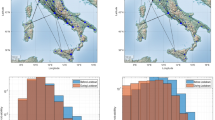Abstract
This paper focuses on the characterization of viability zones in compartmental models with varying population size, due both to deaths caused by epidemics and to natural demography. This is achieved with the use of viscosity characterizations of viability and extensively illustrated on several models. An example taking into consideration real data is provided. The paper is completed with a viscosity approach to the optimality of minimal (“greedy”) non-pharmaceutical interventions.







Similar content being viewed by others
Data Availability
The data that support the findings of this study are openly available from INSEE (Institut national de la statistique et des études économiques) at https://www.insee.fr/fr/statistiques/. under the references: 2381380, 2383440.
Notes
in a SIR model, the product \(*\) of exposure is infected individuals, in SEIR models \(*\) stands for exposed, etc.
The affinity is then computed proportionally to the concentrations s and i and to the interaction “speed” \(\beta \) tempered with the control u.
Of course, the notion of input (variable) is to be separated from what one might use in automatic sense (in which the controls u are the inputs).
It is then clear for the reader that, in a SI(R) model, in which the input variables are S and I, these restrictions sum up to \({\mathbb {T}}\) being a triangle.
Different authors prefer calling it maximal robust positively invariant zone. Of course, largest and maximal are the same, as are positive(ly) and forward(ly) invariant. We prefer retaining the classical denomination by Aubin.
i.e., search for the smallest lower semicontinuous viscosity supersolution.
According to Cori method and loosely speaking, the basic reproduction number is \(R_0=\beta *c*D\), where \(\beta \) is the risk to get the virus in one contact, c is the number of contacts per time unit (let us say 1!) and D the number of days a person is contagious. In SIR, this corresponds to \(R_0=\frac{\beta }{\gamma }\) since \(\gamma =1/D\) with our notations.
or, equivalently, \(\phi (u)\) for some nonnegative function attaining its strict minimum at \(u_{\max }=1\)
References
Alvarez, F.E., Argente, D., Lippi, F.: A simple planning problem for COVID-19 lockdown. Technical report, National Bureau of Economic Research (2020)
Ames, A.D., Molnár, T.G., Singletary, A.W., Orosz, G.: Safety-critical control of active interventions for COVID-19 mitigation. IEEE Access 8, 188454–188474 (2020)
Anderson, R.M., Anderson, B., May, R.M.: Infectious Diseases of Humans: Dynamics and Control. Oxford University Press, Oxford (1992)
Avram, F., Freddi, L., Goreac, D.: Corrigendum to “Optimal control of a SIR epidemic with ICU constraints and target objectives’’. Appl. Math. Comput. 423, 127012 (2022)
Avram, F., Freddi, L., Goreac, D.: Optimal control of a SIR epidemic with ICU constraints and target objectives. Appl. Math. Comput. 418, 126816 (2022)
Behncke, H.: Optimal control of deterministic epidemics. Optimal Control Appl. Methods 21(6), 269–285 (2000)
Bolzoni, L., Bonacini, E., Della Marca, R., Groppi, M.: Optimal control of epidemic size and duration with limited resources. Math. Biosci. 315, 108232 (2019)
Buckdahn, R., Cardaliaguet, P., Quincampoix, M.: A representation formula for the mean curvature motion. SIAM J. Math. Anal. 33(4), 827–846 (2001)
Delfour, M.C., Zolesio, J.P.: Shape analysis via oriented distance functions. J. Funct. Anal. 123(1), 129–201 (1994)
Esterhuizen, W., Lévine, J., Streif, S.: Epidemic management with admissible and robust invariant sets. PLoS ONE 16(9), 1–28 (2021)
Freddi, L.: Optimal control of the transmission rate in compartmental epidemics. Math. Control Related Fields 12(1), 201–223 (2022)
Freddi, L., Goreac, D., Li, J., Xu, B.: SIR epidemics with state-dependent costs and ICU constraints: a Hamilton–Jacobi verification argument and dual LP algorithms. Appl. Math. Optim. 86(2), 23 (2022)
Hansen, E., Day, T.: Optimal control of epidemics with limited resources. J. Math. Biol. 62(3), 423–451 (2011)
INSEE data. https://www.insee.fr/fr/statistiques/
Ketcheson, D.I.: Optimal control of an SIR epidemic through finite-time non-pharmaceutical intervention. J. Math. Biol. 83, 7 (2021)
Kruse, T., Strack, P.: Optimal Control of an Epidemic through Social Distancing. Cowles Foundation Discussion Papers 2229, Yale University (2020)
Martcheva, M.: An Introduction to Mathematical Epidemiology. Springer, New York (2015)
Sauerteig, P., Esterhuizen, W., Wilson, T., Ritschel, T.K.S., Worthmann, K., Streif, S.: Model predictive control tailored to epidemic models. arXiv:2111.06688 (2021)
Szolnoki, D.: Viability kernels and control sets. ESAIM Control Optim. Calc. Var. 5, 175–185 (2000)
Funding
Dan Goreac, Juan Li and Junsong Li have been partially supported by the National Key R and D Program of China (No. 2018YFA0703901) and the NSF of P. R. China (Nos. 12031009, 11871037).
Author information
Authors and Affiliations
Corresponding author
Additional information
Communicated by Vincenzo Capasso
Publisher's Note
Springer Nature remains neutral with regard to jurisdictional claims in published maps and institutional affiliations.
All the authors have been contributed equally to this paper and should be treated as first authors.
Rights and permissions
Springer Nature or its licensor (e.g. a society or other partner) holds exclusive rights to this article under a publishing agreement with the author(s) or other rightsholder(s); author self-archiving of the accepted manuscript version of this article is solely governed by the terms of such publishing agreement and applicable law.
About this article
Cite this article
Avram, F., Freddi, L., Goreac, D. et al. Controlled Compartmental Models with Time-Varying Population: Normalization, Viability and Comparison. J Optim Theory Appl 198, 1019–1048 (2023). https://doi.org/10.1007/s10957-023-02274-5
Received:
Accepted:
Published:
Issue Date:
DOI: https://doi.org/10.1007/s10957-023-02274-5
Keywords
- Compartmental models
- Epidemics
- Mathematical control
- State constraints
- Viability
- Viscosity solutions
- COVID 19




